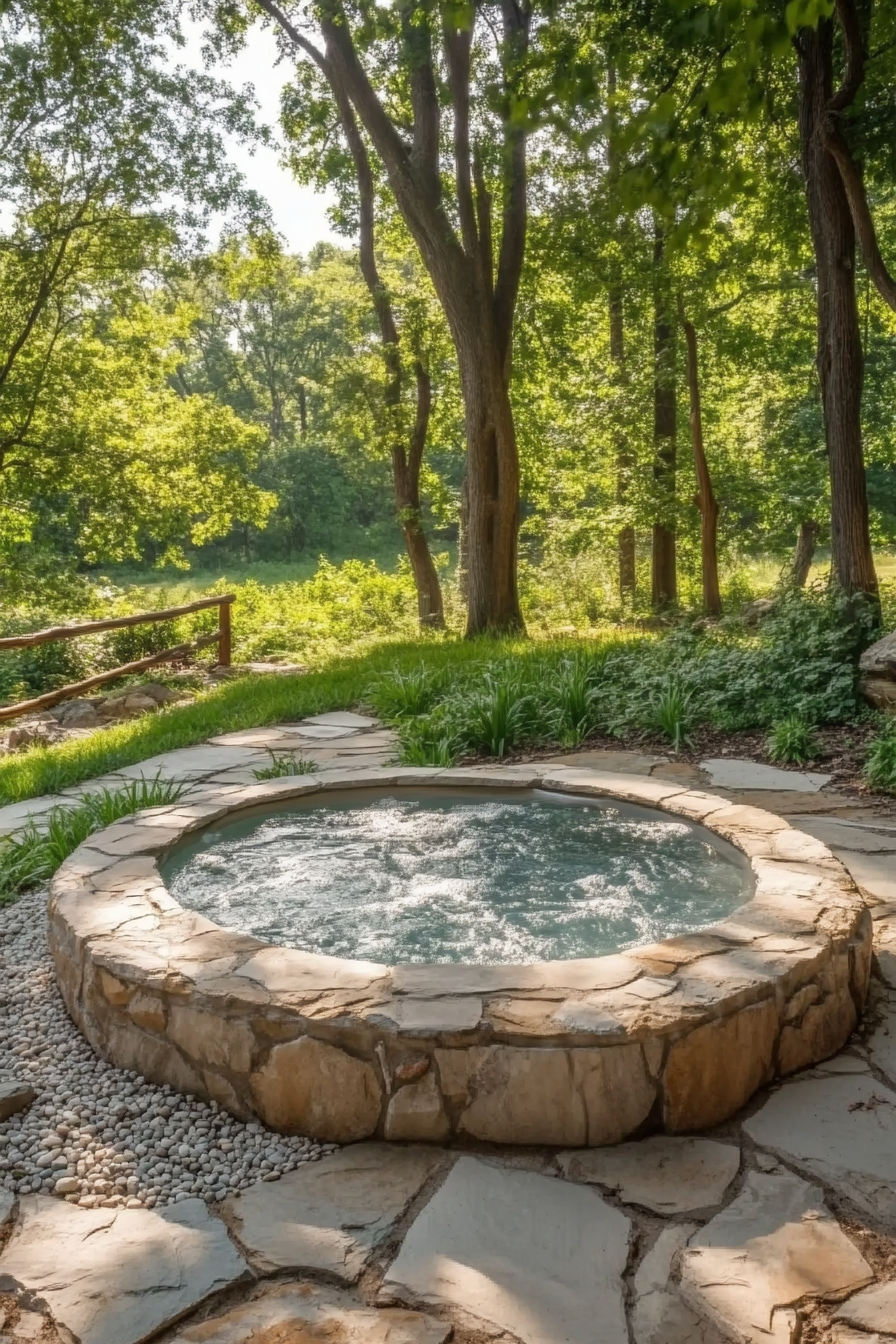Having a hot tub at home is the ultimate way to relax, unwind, and indulge in a little luxury.
However, the area around your hot tub is just as important as the hot tub itself when it comes to creating an inviting, spa-like atmosphere.
The hot tub “pad” refers to the surface that your hot tub sits on and the surrounding area.
With the right hot tub pad design, you can take your backyard oasis to the next level.
We’ll dive into the specifics of each material, from cost to maintenance, so you can make an informed decision.
Get ready to soak up some seriously beautiful hot tub pad inspiration!
✨Click to Get My 101 FREE Designer Room Ideas
Natural Stone Pad
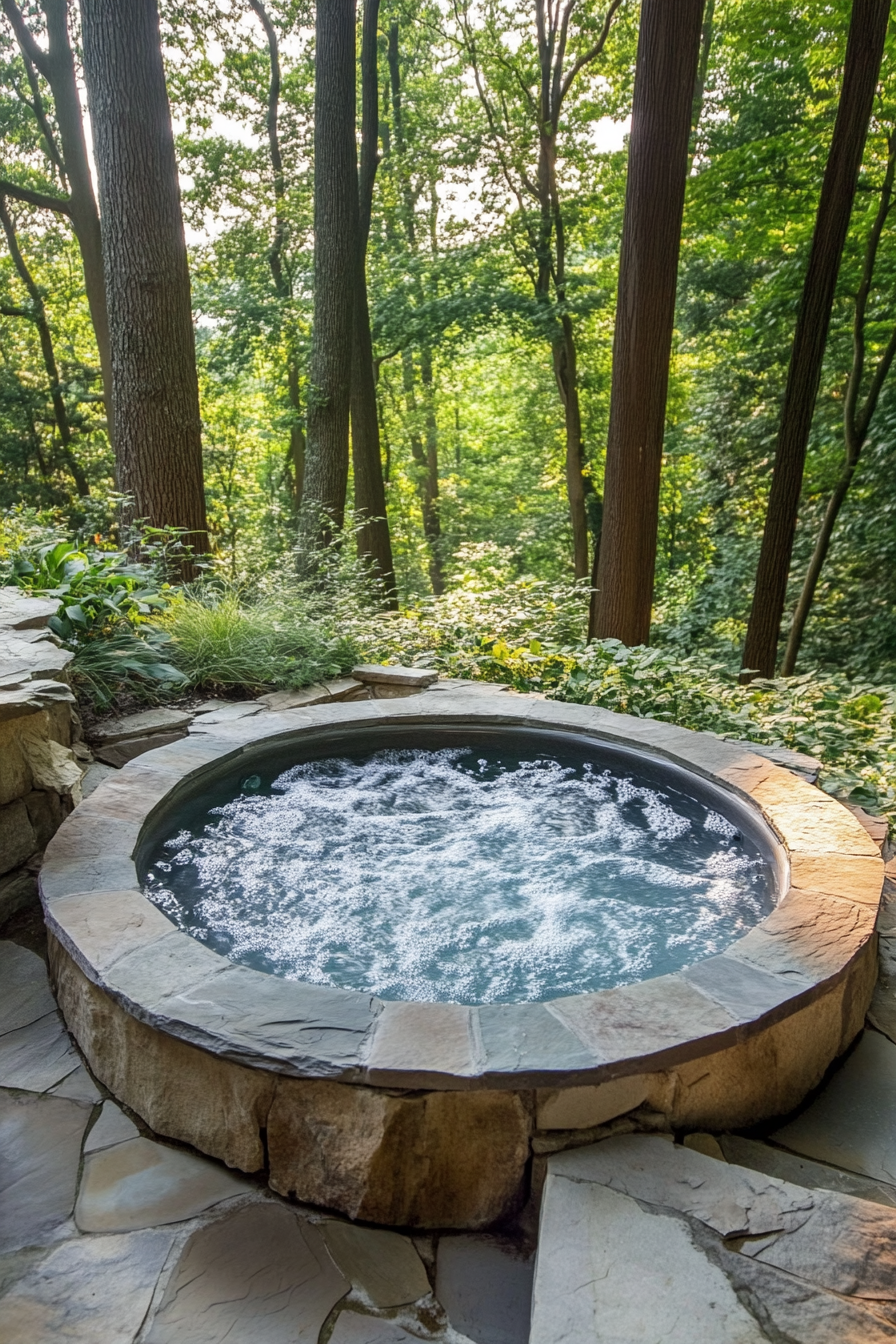
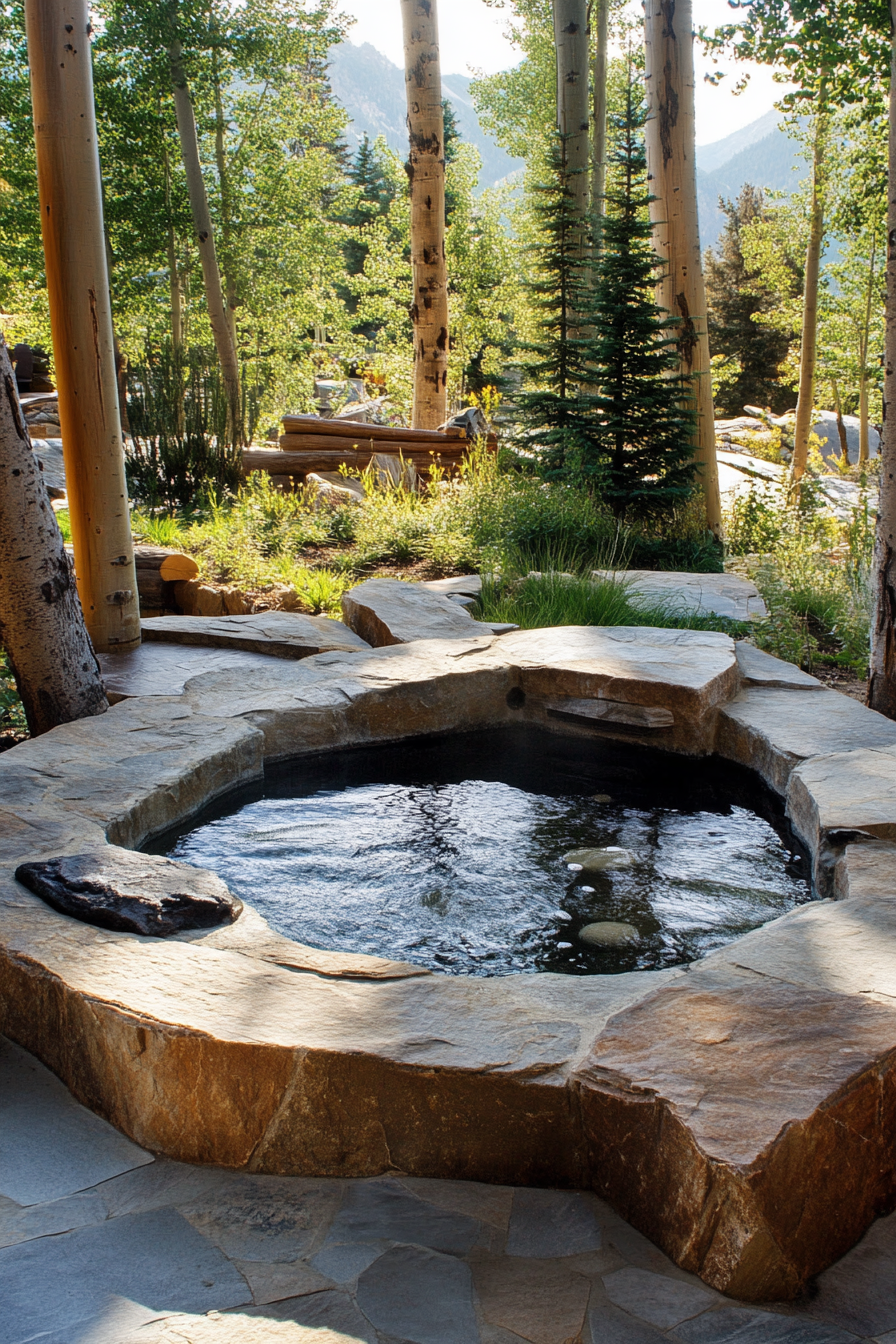
Natural stone is a classic and elegant choice for a hot tub pad.
The rich colors and unique patterns of stone materials like travertine, bluestone, and slate complement both traditional and contemporary backyard designs.
Natural stone pads lend a luxurious, spa-like feel that is hard to replicate with manufactured materials.
Travertine is one of the most popular stones for hot tub pads.
It has an earthy, rustic aesthetic with tan and cream colored striations.
The natural holes and grooves of travertine can make it slippery when wet, so it’s important to go with a tumbled and filled variety for a hot tub pad.
A bluestone pad provides similar organic texture in shades of cool gray, blue, and brown.
Bluestone has a natural non-slip texture, making it ideal for areas that get wet.
Slate stands out with its dark charcoal and black tones.
The layered slate texture adds dramatic contrast and sophistication.
Like bluestone, slate has an innate slip-resistance.
One thing to keep in mind is that slate can retain heat from the hot tub, making it warmer underfoot.
Building a custom natural stone pad is an investment, starting around $15 per square foot installed, but it makes a gorgeous permanent foundation for your backyard oasis.
Opting for stone tile cuts costs but provides a similar look.
Regular sealing is required to prevent natural stone from staining.
Wood Deck Pad

Wood decks make a classic, timeless choice for a hot tub pad.
The rich grain patterns and natural warmth of wood complement hot tubs beautifully.
Decks designed specifically to surround a hot tub are often built as low-profile platforms to keep the top of the tub accessible.
This creates a clean, seamless transition from decking boards to hot tub cover.
Pressure-treated pine is the most budget-friendly wood decking material, great for creating simple rectangular platforms.
Composite decking offers many wood looks with added durability and less maintenance, starting around $15 per square foot.
It’s important to choose woods or composites rated for ground contact, since any wood touching the ground directly could rot.
Proper water sealing and drainage under the deck are also crucial to avoid moisture damage over time.
Building a wood deck pad for your hot tub starts at around $10 per square foot.
While wood requires regular sealing, its natural texture and appearance pair perfectly with backyard hot tubs.
Built-in benches surrounding the pad add extra function and further integrate the hot tub space.
Opt for wider deck boards spaced slightly apart to allow water drainage through the slats.
Concrete Pad
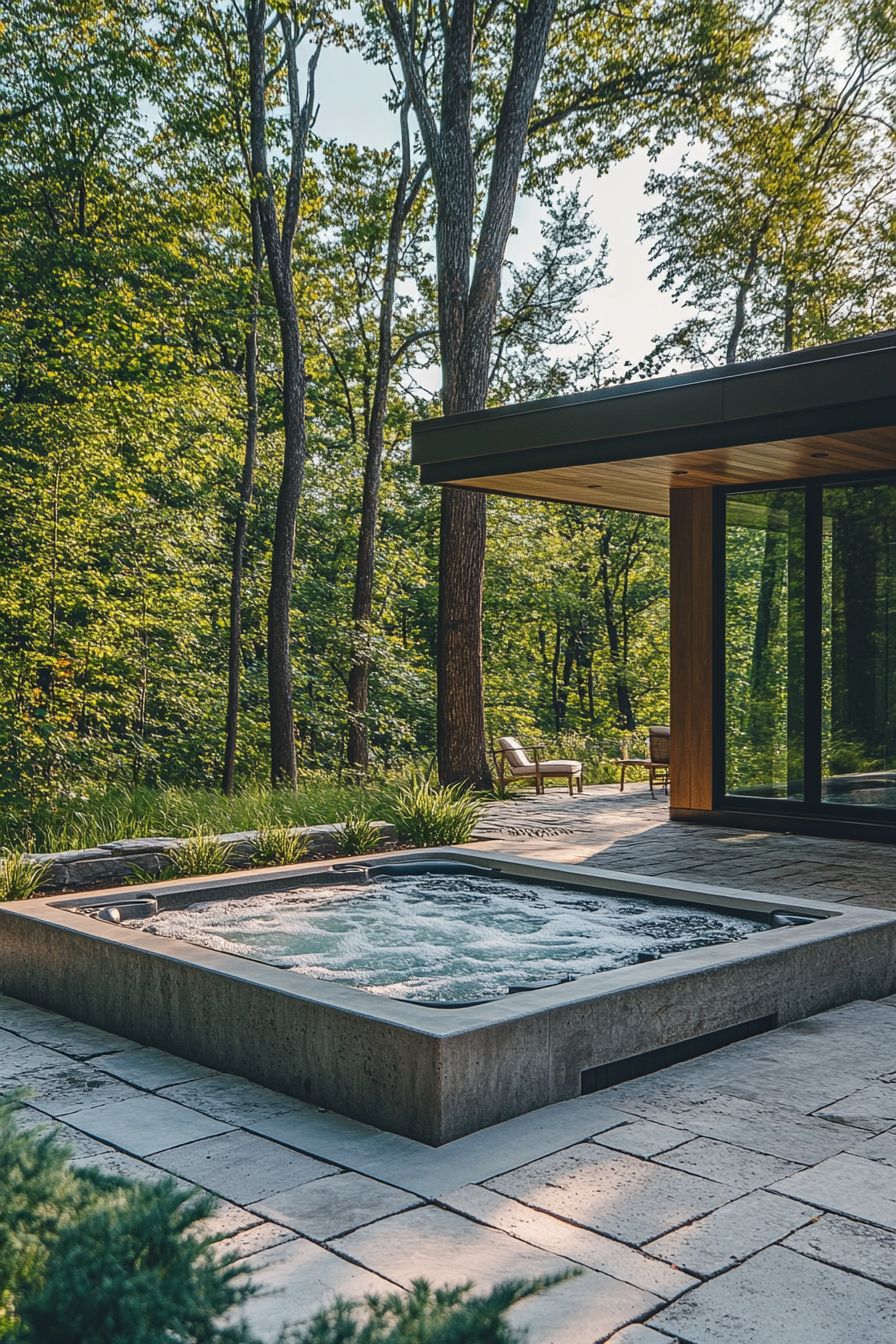
Plain concrete may not seem glamorous, but adding decorative touches transforms it into a stylish hot tub pad.
Concrete offers unbeatable durability and customization options.
With the right finishes and details, concrete becomes a contemporary, eye-catching foundation for your hot tub.
For a sleek look, opt for stamped concrete imprinted with stone, wood, or geometric patterns.
Popular aggregate finishes like exposed quartz, glass, and seashells blend color and texture.
For a pop of brightness, acid-stain concrete in vibrant hues.
Or add radiant heating coils below the surface to keep feet warm on chilly nights.
Designing contrasting border bands, quarterbacking squares, or a decorative compass emblem makes a concrete hot tub pad more interesting.
Building up the pad slightly allows you to add steps or built-in benches for function and flair.
Standard gray concrete starts around $5 per square foot, with finished options adding $2-4 for materials and labor.
Concrete’s long lifespan and minimal maintenance make it a sound investment.
Just be sure to allow 4-6 weeks concrete curing before filling your hot tub.
Pea Gravel Pad
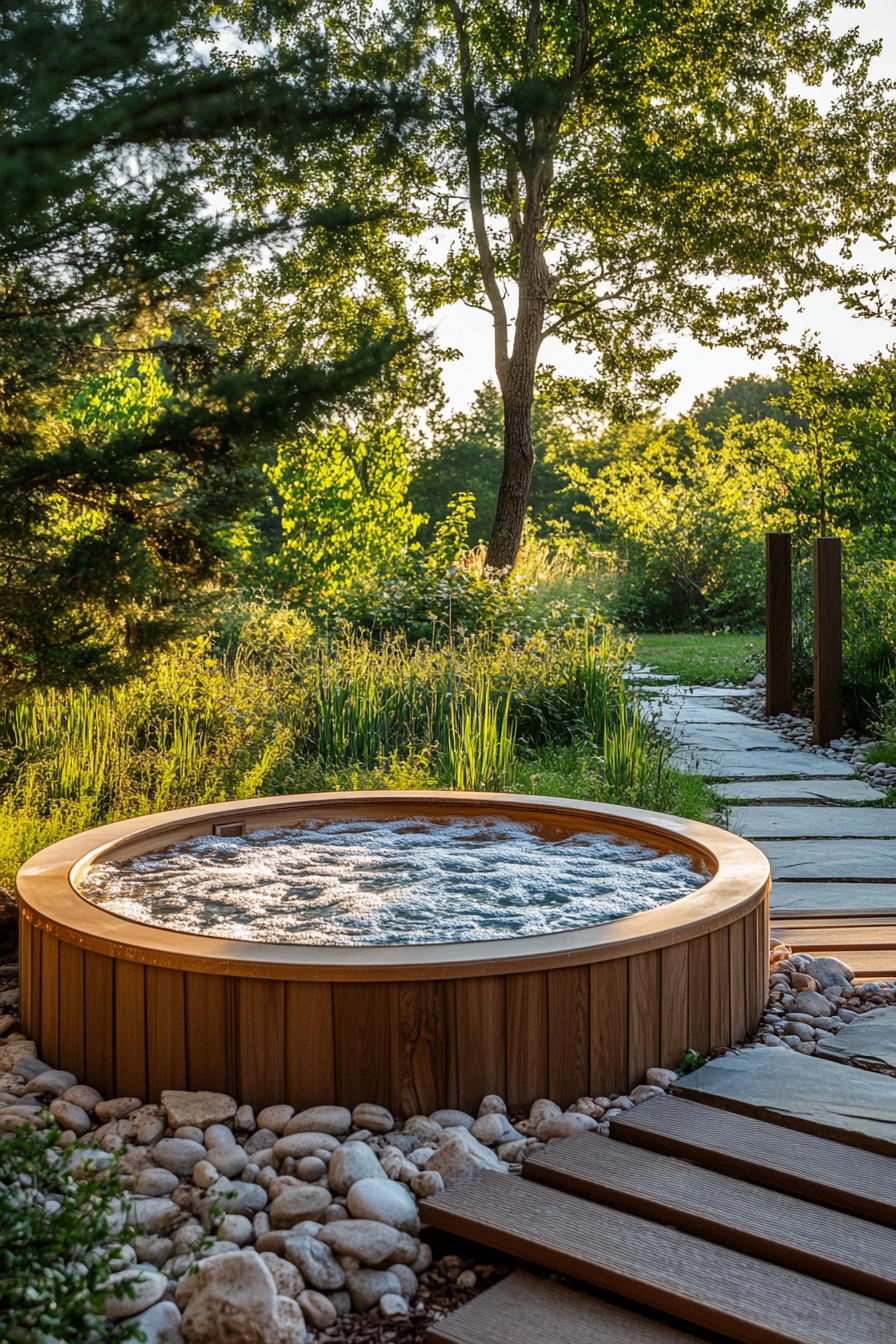
For a casual, natural vibe, try covering your hot tub pad area with pea gravel.
The small, smooth stones create a soft, forgiving surface surrounding your hot tub.
Pea gravel comes in earthy neutrals like tans, browns, and grays that blend easily with both rustic and contemporary landscaping themes.
Pea gravel pads have great drainage to prevent puddling issues.
The loose gravel stones won’t crack or shift like solid materials.
You can easily move or add stones as needed over time.
Keeping the area weed-free takes more effort than with solid pads.
Install a gravel retaining border to keep the pea gravel in place.
Plastic landscape edging keeps gravel from spreading at an affordable price of $2-4 per linear foot.
Brick, stone, or concrete borders add a decorative touch for $10-25 per foot installed.
Pea gravel costs $40-60 per cubic yard, or around $0.50-1 per square foot.
Delivery fees add $50-100 for smaller projects.
Install a soil and weed barrier cloth before spreading 4-6 inches of gravel for optimum padding.
Pea gravel compacts over time with use, so expect to add more gravel every few years.
The loose stones may also scatter when using your hot tub cover.
But for an informal, adaptable pad, pea gravel is a great option.
✨Click to Get My 101 FREE Designer Room Ideas
Paver Stone Pad
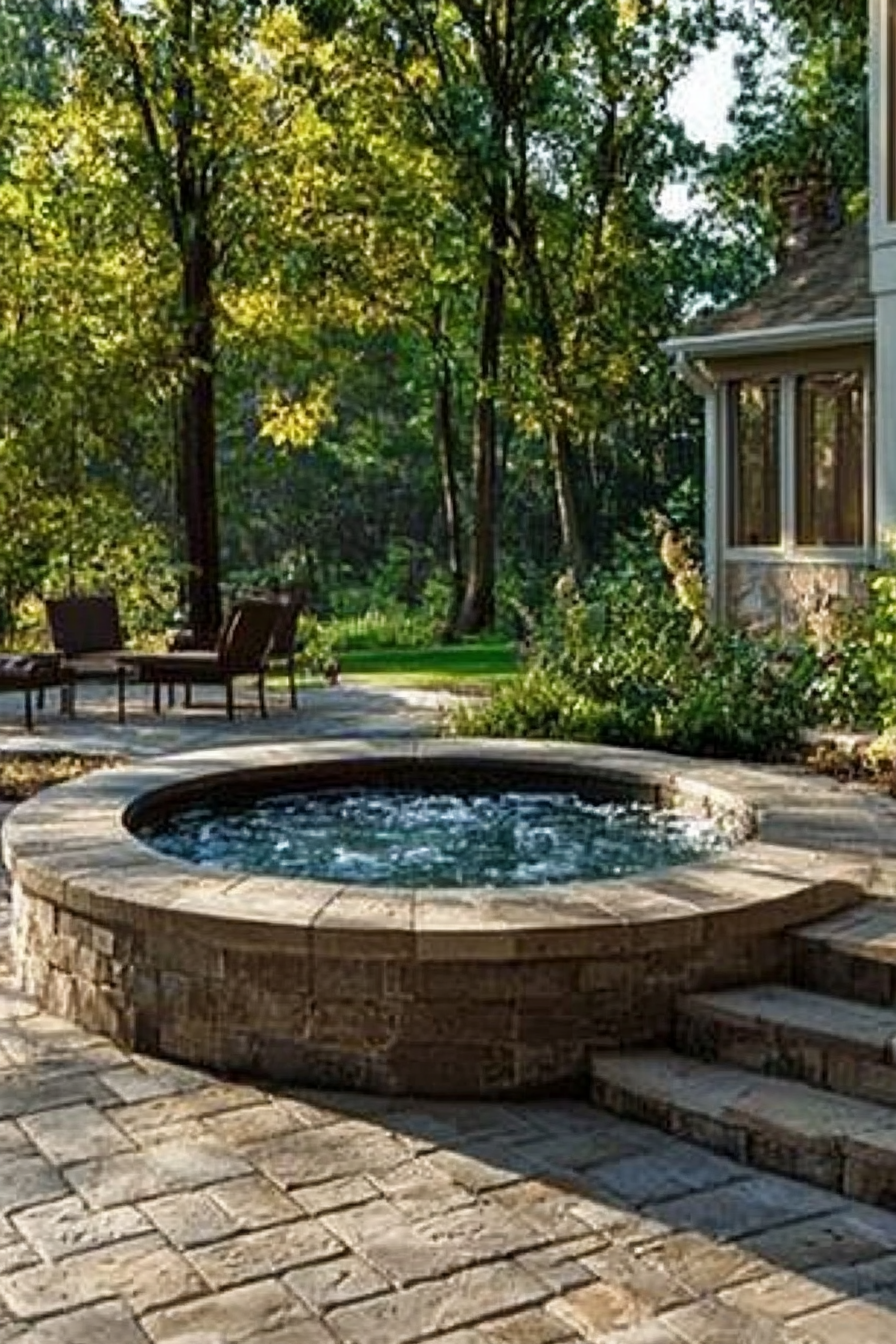
Individual paver stones make a brilliant hot tub pad option with tons of design flexibility.
Available in natural stone, concrete, porcelain, and more, pavers come in endless sizes, shapes, colors, and patterns to create custom designs.
The small units also allow you to seamlessly work around landscaping elements and tricky corners.
Common paver types like travertine, bluestone, limestone, and granite bring the beauty of natural stone in modular pieces for easier DIY installation.
Concrete pavers offer similar visuals in more budget-friendly options.
Permeable concrete pavers allow drainage between the joints.
Porcelain enamel pavers add bold color choices and intricate patterns not found in natural stone.
Laying a paver patio or plaza as your hot tub foundation costs $10-20 per square foot, including installation and base preparation.
Opt for tumbled stone varieties or add aggregate mix joints between pavers to prevent slick or uneven surfaces.
Keep an eye out for weeds growing between paver joints over time.
The modular nature of paver stones lets you expand or adapt your hot tub pad anytime.
And choosing unique shapes, colors, and layout patterns results in a custom pad that suits your style.
Poured Concrete Pad
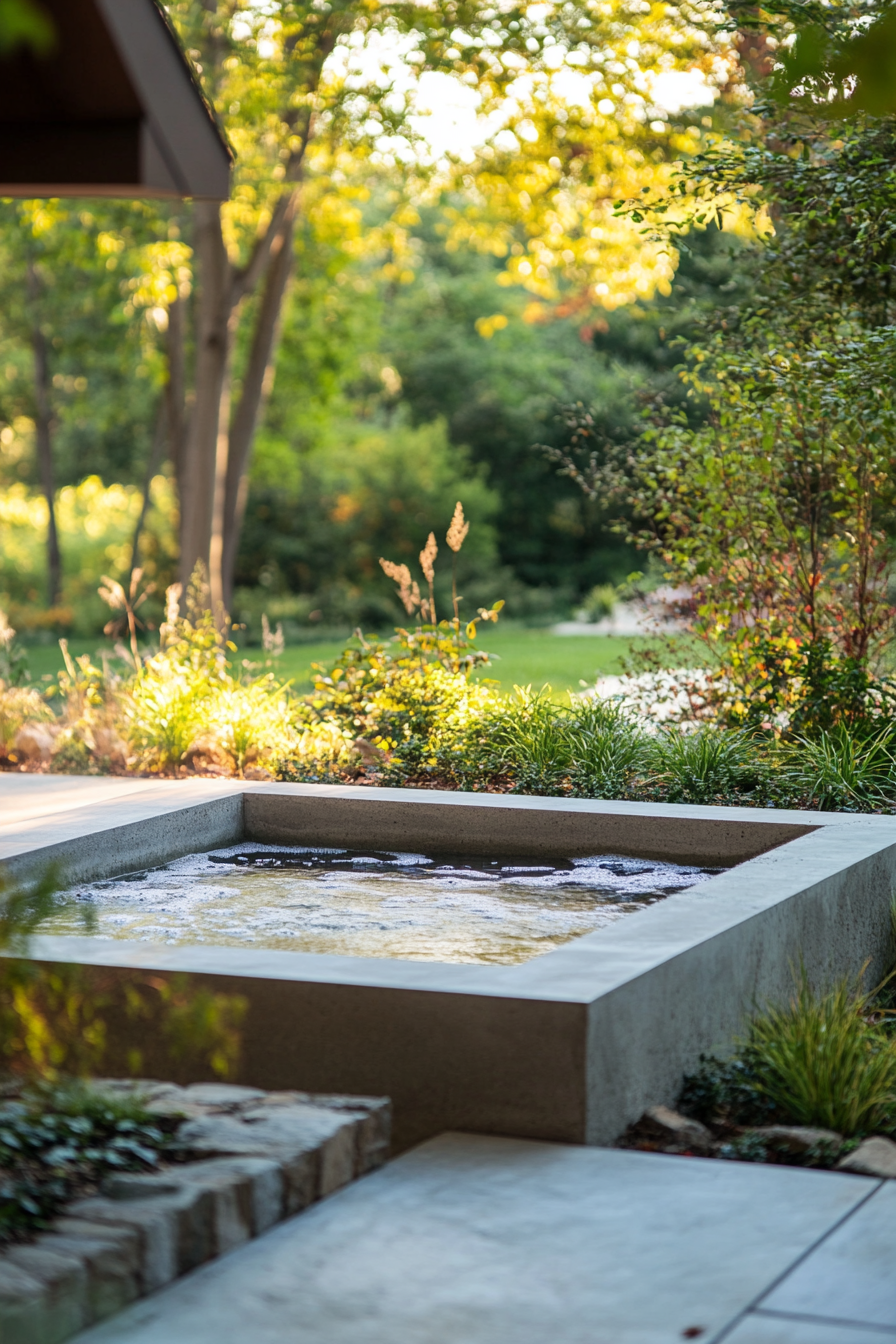
Poured concrete slap pads provide an affordable, low-maintenance hot tub foundation.
The single, continuous concrete surface is durable and long-lasting.
Concrete’s neutral solid gray tone works with any landscaping environment.
For better traction, add a broomed, brushed, or stamped finish when the concrete is poured.
Or imprint concrete patterns like stone, wood planking, or geometric shapes.
Integral concrete color in bold shades like crimson, chocolate, or sapphire creates contemporary drama.
Keep poured concrete pads simple with clean lines, or incorporate new shapes like curves or angles.
Add steps, benches, planters, or other features seamlessly during pouring.
Poured concrete does require forming, so unique shapes or small additions may increase cost.
A basic 4-6 inch poured concrete slab starts around $5-8 per square foot, with finishing options adding $1-2 per square foot.
Allow at least 2-4 weeks full curing before hot tub use.
Sealing the concrete regularly prevents staining.
Brick Pad
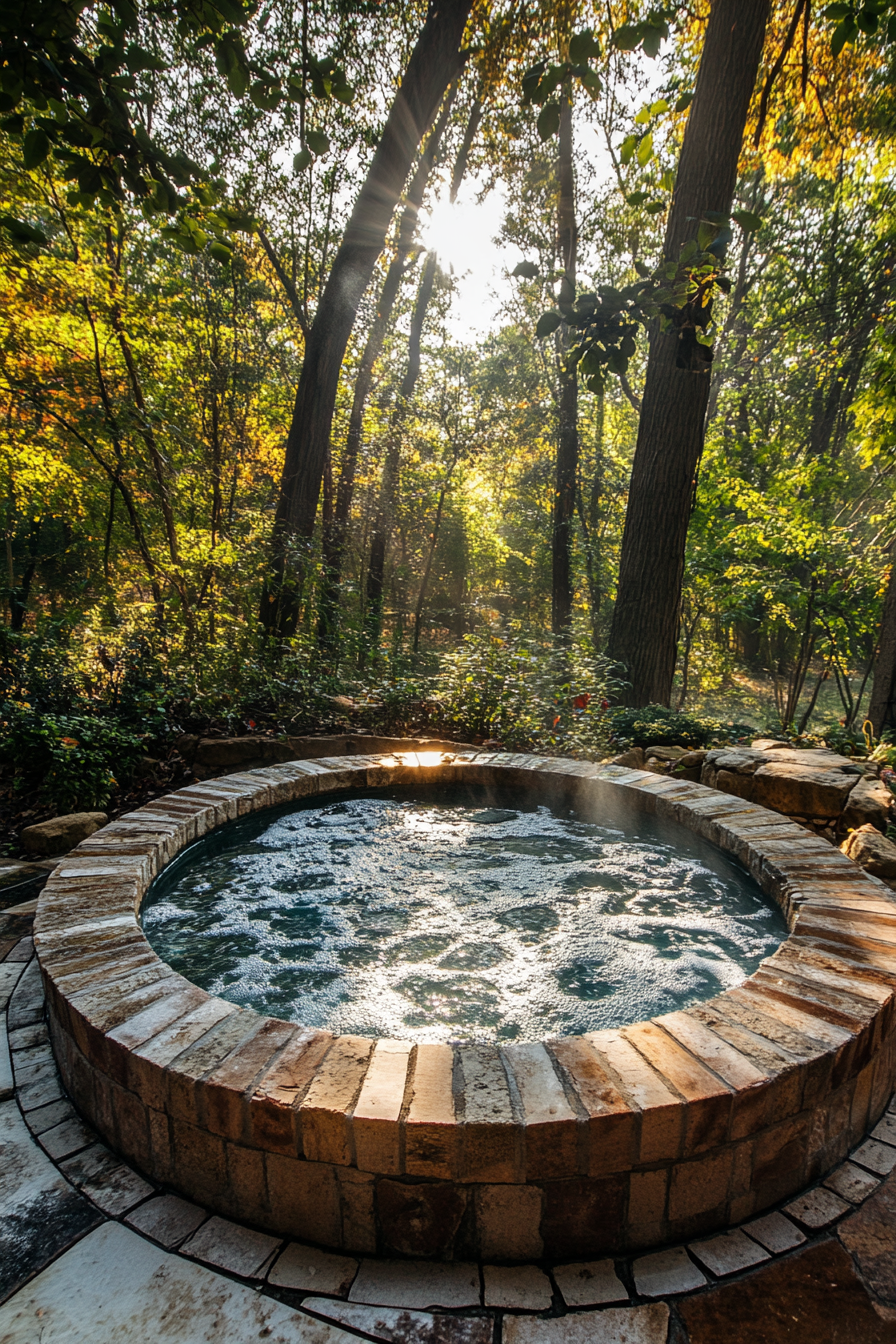
For old-world charm and timeless aesthetics, brick makes a lovely traditional hot tub pad.
Both clay and concrete brick varieties come in classic red hues, warm earth tones, and weathered pastels to suit your style.
Mix colors and patterns to create striking designs.
Lay bricks over a concrete base or footing.
Opt for a simple grid, angled herringbone, or interlocking patterns based on the shape of your hot tub and space.
Keep narrow mortar joints between bricks for a cleaner look that’s also more slip-resistant.
Brick has excellent durability and ages beautifully over time.
Expect to pay $15-25 per square foot for materials and installation of a brick hot tub pad.
Keep an eye out for weeds growing in the mortar joints seasonally.
Padding the ground below with sand or gravel allows you to remove and rearrange bricks later if desired.
This allows you to expand or renovate your hot tub pad down the road.
However, brick laid directly on a concrete slab base provides the most long-lasting foundation.
Tile Pad
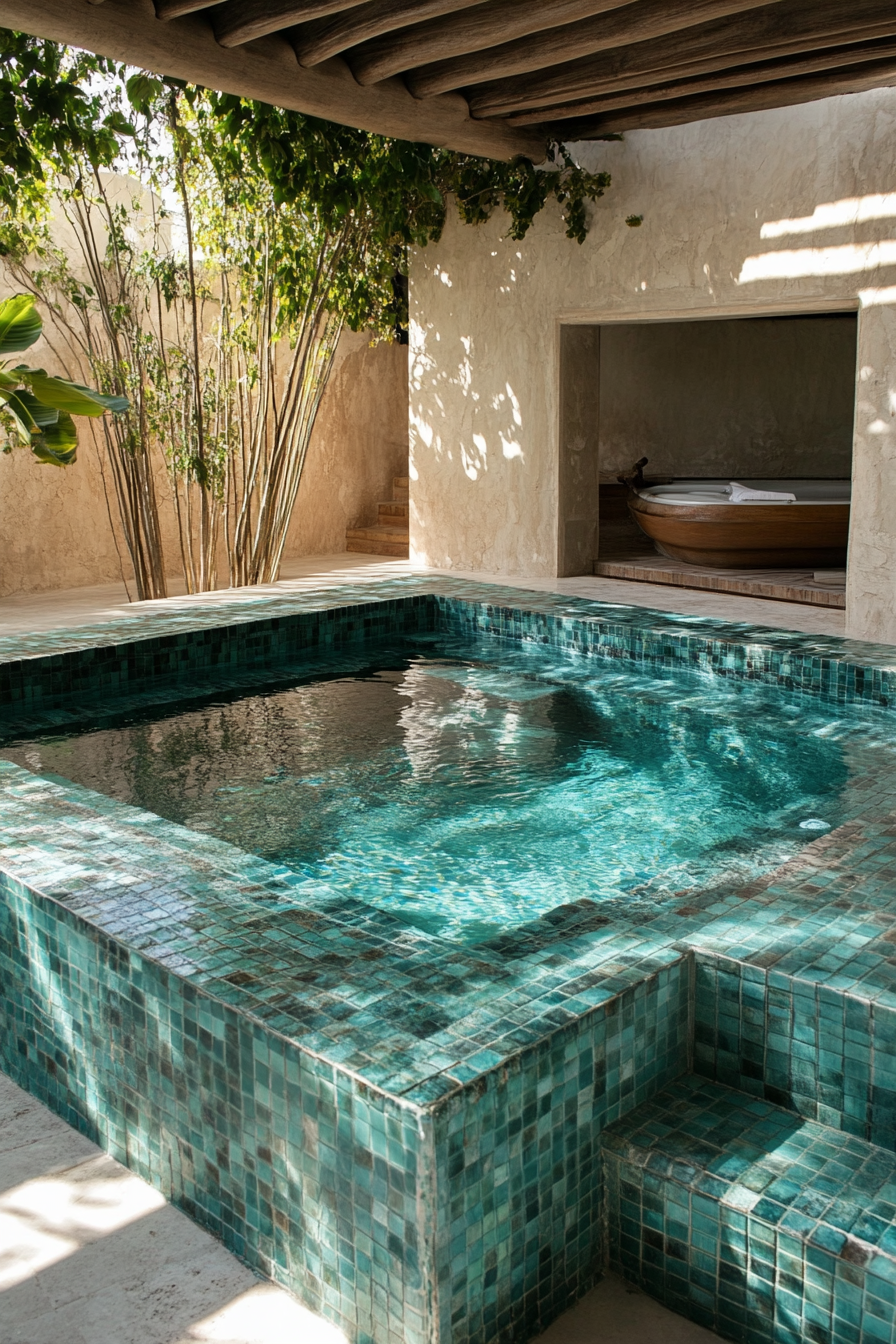
Ceramic, porcelain, or natural stone tile in vibrant colors, interesting shapes, and eye-catching patterns create a showstopping hot tub pad.
Choose tiles sized appropriately for the space to avoid frustrating cuts—large format tiles 12”x24” or bigger have a clean, seamless look.
Keep the overall tile design simple to prevent a busy, distracting pad.
Opt for solid colored tiles with a border or accent strip, or a single bold mosaic tile rug.
Include anti-slip tile on the hot tub-facing edge of the pad or surrounding steps.
Tile costs $10-25 per square foot installed depending on material and complexity.
Allow extra labor time for cutting odd-shaped tiles to fit specific areas.
Grout selection is also important—choose epoxy grout for the best waterproofing and durance.
Properly preparing the subsurface and using a flexible adhesive is crucial to prevent cracking or shifting of the tile over time, especially with natural stone.
An improperly installed tile pad can lead to extensive repairs down the road.
Ensure at least a 1 degree slope for proper drainage across the entire pad.
Overall, tile pads provide visual impact that pairs beautifully with contemporary hot tubs.
Just be sure to choose slip-resistant materials and allow for proper installation and subsurface preparation in your budget.
✨Click to Get My 101 FREE Designer Room Ideas
Gravel Pit Pad
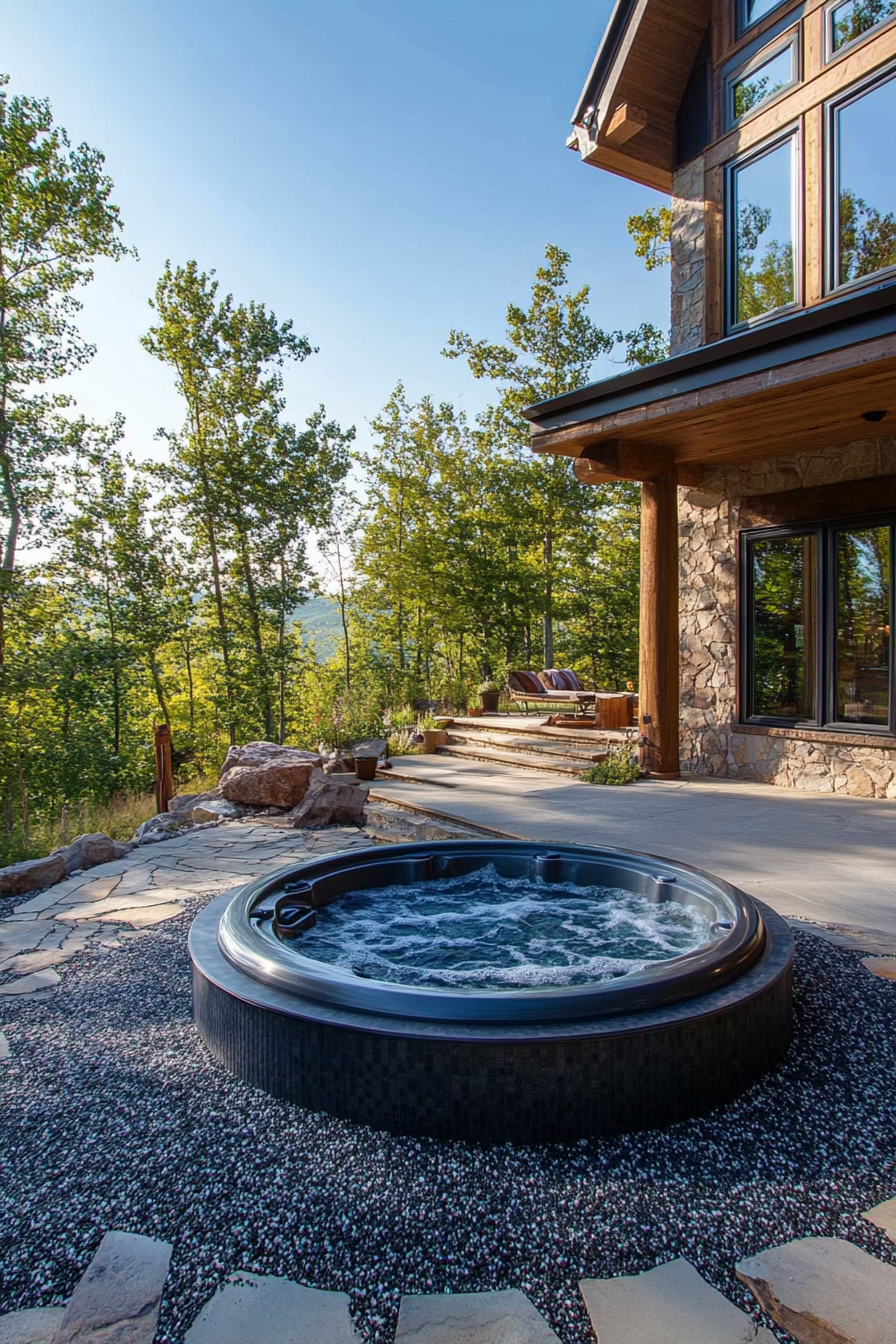
For a fun, festive hot tub pad, incorporate a sunken fire pit area beside or adjacent to the tub surrounded by pea gravel or crushed stone.
The fire extends the hot tub experience into cooler evenings while providing a cozy gathering place.
Circle the pit with built-in seats or place portable chairs and loungers in the gravel area.
Surround the entire pad with a retaining border to keep the loose gravel contained.
This also acts as a visual and textural border between the gravel pad and any lawns or plantings.
Opt for natural edging like cut stone blocks or landscape timber, or sleek precast concrete borders.
Include drainage gravel and underground weep holes below the pea gravel layer to prevent pooling water.
Situate the fire safely 10+ feet from the hot tub with seating in between.
Pick fire resistant gravel like granite chips instead of pea gravel around the immediate fire pit.
Adding a stone hearth pad both protects the gravel base and provides additional hardscaping to balance the loose stone.
Budget $50 per square foot for the overall pad installation including borders, subsurface, gravel, and decorative features like the hearth.
Fire permits are required for permanent backyard fire pits in most areas.
Deck and Planter Pad

Surrounding your hot tub with an elevated wood deck while sectioning off one side with a built-in planter creates an intimate escape.
The deck provides a natural nearby space to lounge, dine, or entertain.
Built-in benches lining the planter offer extra relaxed seating.
Use stone, concrete, metal, or masonry block to construct the low planter wall.
Include gravel, drainage stones, and landscape fabric beneath the soil to allow drainage and prevent soil settling issues over time.
Plant easy care florals, grasses, shrubs, or bamboo to add color and screen views while framing the space.
Choose pressure treated wood, composite boards, or hardwoods for the decking based on budget.
Elevate the deck just 6-12 inches above grade for easy entry into the hot tub.
Incorporate wide steps and railings for safety.
Extending the deck to create partial coverage over part of the hot tub itself helps define the space.
Factor in $15-30 per square foot to cover deck materials, planter construction, and finishes.
Opting for stone or concrete materials on the planter walls boosts costs closer to $30 per square foot.
Well worth the investment for a private backyard sanctuary.
Gravel and Stepping Stone Pad
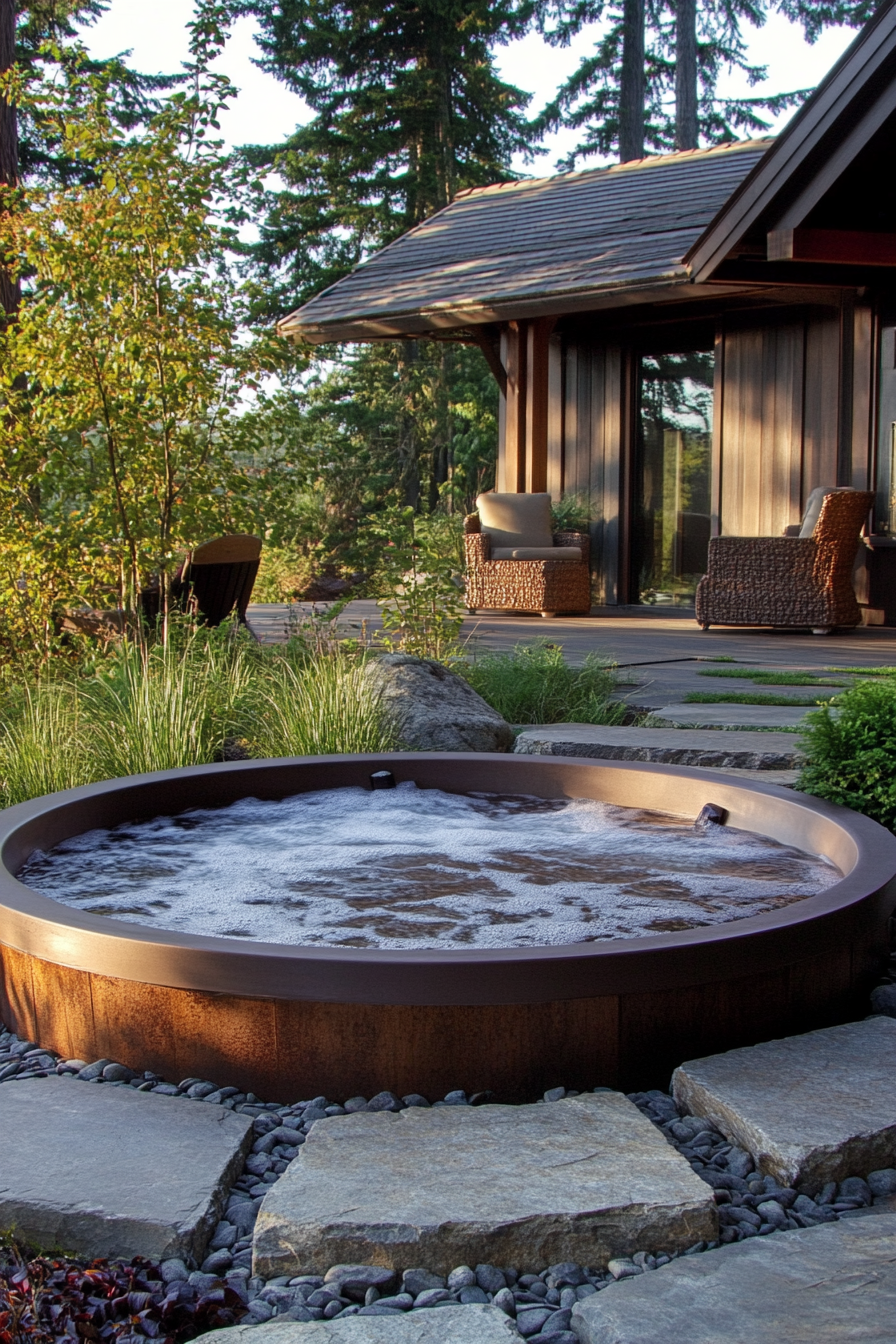
For a casual, eclectic hot tub pad, combine loose pea gravel with large stepping stones meandering through the space.
The contrasting textures add interest while breaking up the pea gravel visually.
Stepping stones also provide a pathway for accessing the hot tub.
Choose varied natural hues for the stone pavers to complement the gravel, like weathered gray, aged brown, ochre, sandstone, and walnut.
Sizes ranging from 12 inch rounds up to 24-36 inch squares work well to navigate comfortably.
Ensure at least a 1-2 inch gravel buffer surrounds each stone to prevent shifting and allow proper drainage.
Install heavy duty landscape edging or timber borders to contain the gravel pad area.
Allow a continuous swath of gravel around one long side of the hot tub for access, then place large stepping stones sporadically through the remaining space.
Keep patios and walkways out of the gravel bordered area to avoid loose stones migrating away from the pad.
The eclectic combination of loose pea gravel with solid stepping stones creates a casual, organic hot tub pad for approximately $10-15 per square foot.
Embrace the imperfection of keeping the gravel and stones looking artfully unarranged.
Cut Stone and Pea Gravel Pad

For a unique blend of contemporary and natural, combine irregular cut stone bands with loose pea gravel.
Contrasting the geometric lines of cut stone with the organic texture of gravel makes the pad visually intriguing.
Use cut basalt or limestone edging to define the overall pad perimeter first.
Then divide the interior into angular sections based on your hot tub dimensions using additional strips of cut stone.
Fill the sections with small river rock or pea gravel.
The stone pieces provide structure while the gravel allows drainage and flexibility.
Leaving some sections filled with grass or plantings prevents a sea of gravel visually.
Bluestone, travertine or quartzite cut stone contrasts beautifully with tan pea gravel.
Part of the appeal of this pad design is the raw, unrefined blend of materials.
Budget around $15-20 per square foot allowing wiggle room for imperfectly placed hand-cut stone pieces and raked gravel.
The result is an organically chic, ecologically inspired pad.
✨Click to Get My 101 FREE Designer Room Ideas
Geometric Tile and Gravel Pad
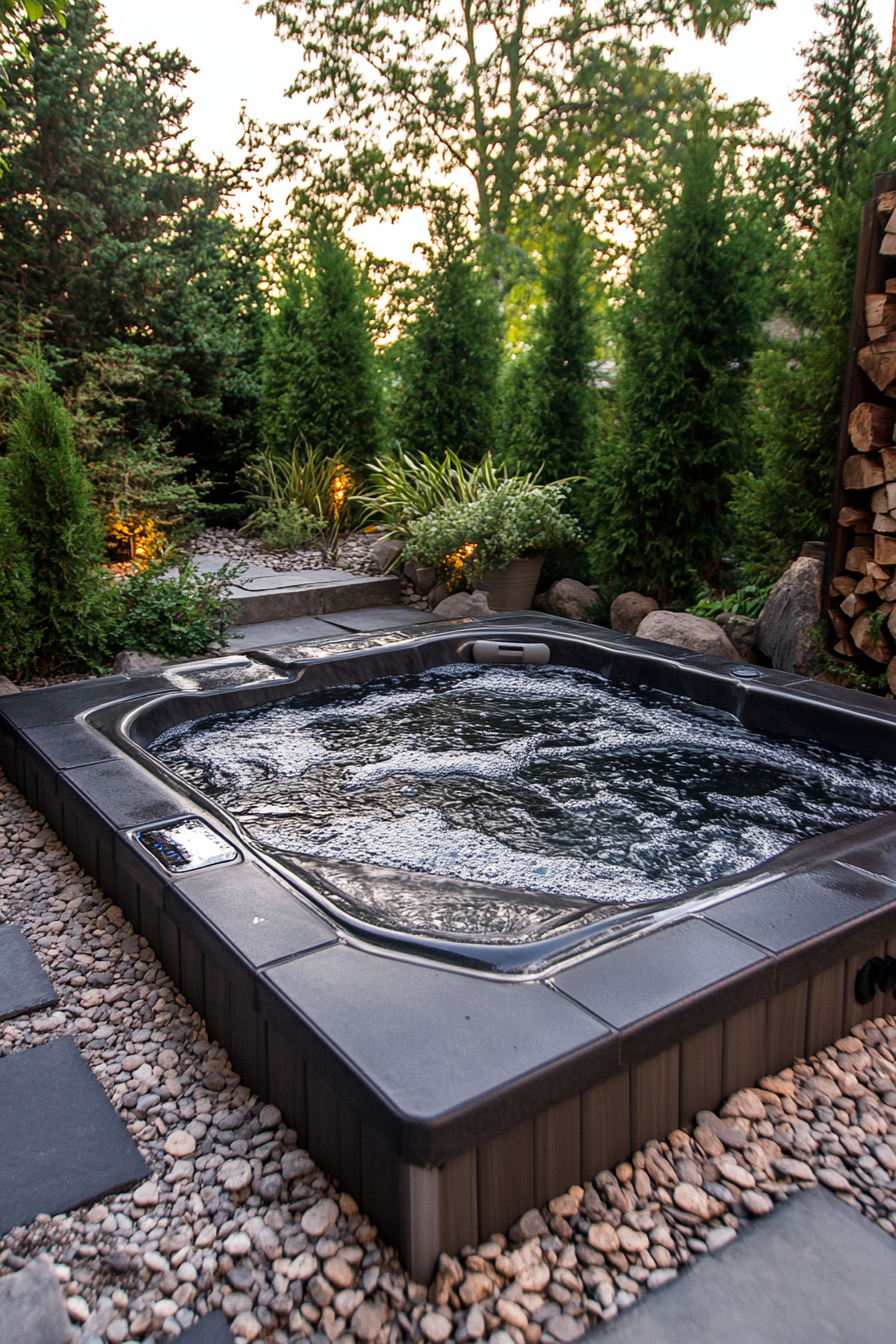
For contemporary pops of color, look to bright geometric cement tiles contrasted with neutral pea gravel.
Cement tiles come in every bold shade imaginable, from ruby red to lemon yellow to navy blue and more.
Combine with softer beiges and taupes for balance.
Use cement tiles selectively on a central area for the hot tub to sit directly on, then surround with pea gravel.
This provides needed hardscaping while allowing drainage and ease of access.
For high contrast, choose a darker gravel that makes the tiles pop.
Cement tiles start around $10 per square foot.
Add another $5-10 per square foot for mortar and gravel installation.
Use cement board below the tile and include expansion joints to allow for cracking between tiles over time.
Keep remaining visible gravel raked and uniform around the pad perimeter.
The combination of radiant geometric tile with informal pea gravel makes a striking modern statement.
Let the bold tiles be the star and keep landscaping and other features simple.
The artistic tile pattern reflects the creativity of your perfect backyard oasis.
The area surrounding your hot tub is just as integral to the overall backyard experience as the tub itself.
With endless options from natural stone to sleek concrete to eclectic gravel designs, creating your dream hot tub pad is all about finding the right materials and features that complement your landscape.
Focus first on choosing slip-resistant, durable surfaces rated for wet areas and direct ground contact.
Then explore finishes and accents that allow you to infuse personality and your unique style into the space.
And don’t forget about adding extra touches like steps, seating, planters, and lighting to enhance the functionality and ambiance.
With proper construction and preparation, your hot tub pad can last for many years of soaking and relaxation to come.
No matter your desired look—traditional or modern, casual or polished—you’re sure to find a perfect hot tub pad idea here to inspire your backyard oasis vision and take it to the next level.
Time to relax!

